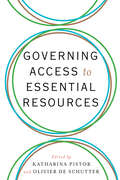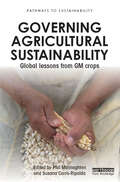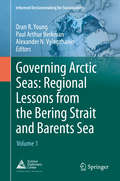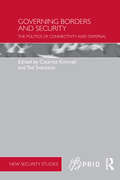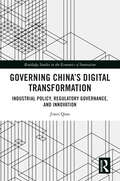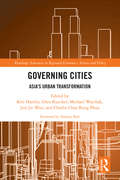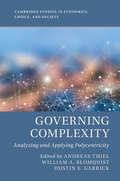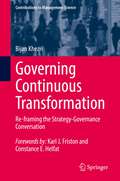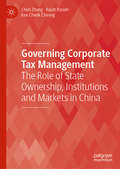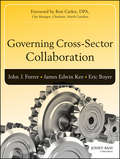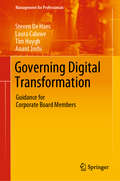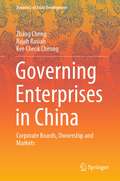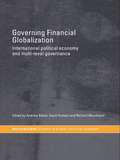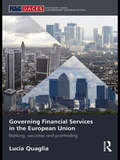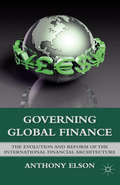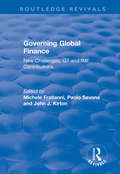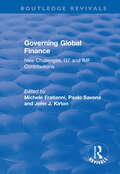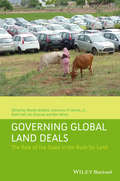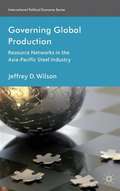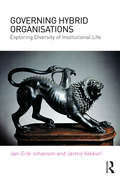- Table View
- List View
Governing Access to Essential Resources
by Olivier De Schutter Katharina PistorEssential resources do more than satisfy people's needs. They ensure a dignified existence. Since the competition for essential resources, particularly fresh water and arable land, is increasing, and standard legal institutions, such as property rights and national border controls, are strangling access to resources for some while delivering prosperity to others, many are searching for ways to ensure their fair distribution. This book argues that essential resources ought to be governed by a combination of Voice and Reflexivity. Voice is the ability of social groups to choose the rules by which they are governed. Reflexivity is the opportunity to question one's own preferences in light of competing claims and to accommodate them in a collective learning process. Having investigated the allocation of essential resources in places as varied as Cambodia, China, India, Kenya, Laos, Morocco, Nepal, the arid American West, and peri-urban areas in West Africa, the contributors to this volume largely concur with the viability of this policy and normative framework. Drawing on their expertise in law, environmental studies, anthropology, history, political science, and economics, they weigh the potential of Voice and Reflexivity against such alternatives as the pricing mechanism, property rights, common resource management, political might, or brute force.
Governing Agricultural Sustainability: Global lessons from GM crops (Pathways to Sustainability)
by Phil Macnaghten Susana Carro-RipaldaAlthough GM crops are seen by their advocates as a key component of the future of world agriculture and as part of the solution for world poverty and hunger, their uptake has not been smooth nor universal: they have been marred by controversy and all too commonly their regulation has been challenged as inadequate, even biased. This book aims to understand these dynamics, examining the impacts of GM crops in diverse contexts and their potentials to contribute to sustainable agricultural futures. Part 1 draws on research from three global ‘rising powers’ – Brazil, India and Mexico – exploring the views of scientists, farmers and publics. Using a diverse array of ethnographic and qualitative methodologies, the book examines the dynamics that have underpinned the controversy in three diverse geo-political contexts, the manner in which dominant institutional framings have been closely aligned with the interests of powerful elites, and the multiple ways in which these have been resisted through local, symbolic and material practices. Part 2 comprises a series of short comment pieces from 11 leading social and natural scientists responding to the question of how to develop a policy framework for the responsible innovation of sustainable, culturally appropriate and socially just agricultural GM technologies. This innovative book offers new insights for researchers and postgraduates in Science and technology studies, Agro-ecology and Environmental Studies, Development studies, Anthropology, Human Geography, Sociology, Political Science, Public Administration, Latin American studies, and Asian studies.
Governing Arctic Seas: Volume 1 (Informed Decisionmaking for Sustainability)
by Oran R. Young Paul Arthur Berkman Alexander N. VylegzhaninGoverning Arctic Seas introduces the concept of ecopolitical regions, using in-depth analyses of the Bering Strait and Barents Sea Regions to demonstrate how integrating the natural sciences, social sciences and Indigenous knowledge can reveal patterns, trends and processes as the basis for informed decisionmaking. This book draws on international, interdisciplinary and inclusive (holistic) perspectives to analyze governance mechanisms, built infrastructure and their coupling to achieve sustainability in biophysical regions subject to shared authority. Governing Arctic Seas is the first volume in a series of books on Informed Decisionmaking for Sustainability that apply, train and refine science diplomacy to address transboundary issues at scales ranging from local to global. For nations and peoples as well as those dealing with global concerns, this holistic process operates across a ‘continuum of urgencies’ from security time scales (mitigating risks of political, economic and cultural instabilities that are immediate) to sustainability time scales (balancing economic prosperity, environmental protection and societal well-being across generations). Informed decisionmaking is the apex goal, starting with questions that generate data as stages of research, integrating decisionmaking institutions to employ evidence to reveal options (without advocacy) that contribute to informed decisions. The first volumes in the series focus on the Arctic, revealing legal, economic, environmental and societal lessons with accelerating knowledge co-production to achieve progress with sustainability in this globally-relevant region that is undergoing an environmental state change in the sea and on land. Across all volumes, there is triangulation to integrate research, education and leadership as well as science, technology and innovation to elaborate the theory, methods and skills of informed decisionmaking to build common interests for the benefit of all on Earth.
Governing Borders and Security: The Politics of Connectivity and Dispersal (PRIO New Security Studies)
by Catarina Kinnvall Ted SvenssonThis book explores and maps the relationship between borders, security and global governance. Theoretically, the book seeks to establish to what degree, and in what ways, traditional notions of borders, security and (global) governance are being eroded, undermined and contested in the context of a globalising world. Borders are increasingly being re-conceptualised to account for connectivity as well as divisions at the same time as focus is shifting from permanence to permeability. The ambivalence ascribed to bordering processes is at heart a security concern; borders are not only entwined with state formation but are also attempts at governing securities, identities and histories. Proceeding from a critical rendering of statist conceptualisations of borders, security and governance, the book not only emphasises the politics of borders, mobility and re-locations, but also provides a shared groundwork for interrogating the spatial conditions for bordering and border work as manifestations of a continuously deferred becoming rather than being. A principal contribution of the volume is its scrutiny of how borders are enacted and perceived in and through the everyday, and of how such production and construal can make sense as acts of resistance to various forms of governing. Such a focus reveals the necessity of investigating how governing from afar affects the possibilities and tendencies to securitise as well as desecuritise, within as well as beyond elite settings. This book will be of much interest to students of border studies, human geography, governmentality, global governance and IR/critical security studies.
Governing Capital: International Finance and Mexican Politics
by Sylvia MaxfieldAs capital moves ever more easily across territorial boundaries, it draws national financial systems into an international web. In the 1980s, capital flows also seemed to spread monetarist economic ideology—from Volcker’s Federal Reserve to Thatcher’s England to Pinochet’s Chile and beyond. The Nobel committee honored a few scattered Keynesians, but few observers would deny that the theory and praxis of nonmilitary demand management died with the Age of Aquarius.
Governing China's Digital Transformation: Industrial Policy, Regulatory Governance, and Innovation (Routledge Studies in the Economics of Innovation)
by Jiwei QianThis book examines China’s digital transformation and its complex policy landscape, offering fresh insights into how the world’s second-largest economy navigates the challenges of governing its rapidly evolving digital sector. Through detailed analysis, it reveals the intricate relationship between technological innovation and policy implementation in contemporary China.The book explores critical themes including digital industrial policies, competition policy, data governance, and artificial intelligence development. It introduces two dynamics: the “digital amplification of fragmentation,” which explains how digital technologies intensify existing governance challenges, and the “technology-policy recursive loop,” which describes the interaction between technological advancement and regulatory responses. Using diverse data sources and covering developments such as China’s 2020–2021 regulatory crackdown of major technology firms like Alibaba and Tencent, the book provides a comprehensive examination of China’s unique approach to digital governance. Special attention is paid to pressing issues such as data security, cross-border data flows, and technological self-reliance.An essential read for policymakers, business leaders, and scholars seeking to understand China’s digital economy and its implications for global digital governance. Its accessible analysis offers valuable insights for anyone interested in the intersection of technology, policy, and economic development in contemporary China.
Governing Cities: Asia's Urban Transformation (Routledge Advances in Regional Economics, Science and Policy)
by Kris Hartley Glen Kuecker Michael Waschak Jun Jie Woo Charles Chao Rong Phua Tommy KohThis book presents the latest research on three issues of crucial importance to Asian cities: governance, livability, and sustainability. Together, these issues canvass the salient trends defining Asian urbanization and are explored through an eclectic compendium of studies that represent the many voices of this diverse region. Examining the processes and implications of Asian urbanization, the book interweaves practical cases with theories and empirical rigor while lending insight and complexity into the towering challenges of urban governance. The book targets a broad audience including thinkers, practitioners, and students.
Governing Complexity: Analyzing and Applying Polycentricity (Cambridge Studies in Economics, Choice, and Society)
by Andreas Thiel William A. Blomquist Dustin E. GarrickThere has been a rapid expansion of academic interest and publications on polycentricity. In the contemporary world, nearly all governance situations are polycentric, but people are not necessarily used to thinking this way. Governing Complexity provides an updated explanation of the concept of polycentric governance. The editors provide examples of it in contemporary settings involving complex natural resource systems, as well as a critical evaluation of the utility of the concept. With contributions from leading scholars in the field, this book makes the case that polycentric governance arrangements exist and it is possible for polycentric arrangements to perform well, persist for long periods, and adapt. Whether they actually function well, persist, or adapt depends on multiple factors that are reviewed and discussed, both theoretically and with examples from actual cases.
Governing Continuous Transformation: Re-framing the Strategy-Governance Conversation (Contributions to Management Science)
by Bijan KhezriThis book transposes the ‘free-energy principle’, as espoused by the neuroscientist Karl Friston, to strategic governance, and forming the new concept of Free-Energy Governance (FEG). This concept lays the foundation for a new logic of governing continuous transformation. In addition to guiding the structure, cognition, and capabilities of success in strategic renewal, FEG provides a systematic and practice-relevant approach to predicting a firm’s potential for entropy.Using this new concept, the author shows that the success of continuous strategic renewal and business innovation, elements crucial for firm survival, are determined by the triplet of a firm’s structure, cognition, and dynamic board capabilities. “How to govern large organizations in times of high uncertainty and permanent change? To answer this pressing question, … Bijan Khezri has been the first to apply [the free energy] principle to management science … This book is an eyeopener for every reflective leader.¨ Professor Oliver Gassmann, Director of the Institute of Management and Technology, University of St. Gallen “I really enjoyed reading this book. It was both exciting and reassuring to see how the same fundamental ideas can be found in fields as disparate as nonequilibrium steady-state physics and theories of governance.” Professor Karl. J. Friston; Director of the Wellcome Centre for Human Neuroimaging “Using a term often applied to best-selling novels, ‘it is a page turner’ in which I learned something new in every chapter! Every board member, all executives and scholars interested in strategic leadership and governance must read this book if they wish to remain relevant in the coming transformational decades.” Michael A. Hitt University Distinguished Professor Emeritus, Mays Business School, Texas A&M University Former President, Academy of Management, and former Editor, Academy of Management Journal "We could not ask for a better author to initiate this new conversation in the board research community and convey its merits to the world of board practice." Martin HilbProfessor Emeritus, University of St. Gallen Founder and Managing Partner, International Board Foundation and President of Swiss Institute of Directors “Set against a wide swath of literature, the book impressively makes the case for a new logic of strategic renewal in which the board of directors plays a central role.” Professor Constance E. Helfat, Tuck School of Business at Dartmouth
Governing Corporate Social Responsibility in the Apparel Industry after Rana Plaza
by Anil Hira Maureen Benson-ReaThis edited collection critically explores the efforts of the apparel industry to improve safety conditions and suggests governance reforms that will resolve lingering issues. The volume examines two consortia: the Alliance and the Accord, which set up cooperative auditing systems of supplying factories and penalties for non-compliance, and include funding to help factories comply and for workers if factories are idled during repairs, though the editors raise doubts about the long-lasting value of such efforts. In the wake of the 2013 Rana Plaza disaster, leading researchers across labor relations and industry studies tackle and debate such issues, giving their perspective of how multinationals operating in developing countries should regulate labor standards in order to resolve and improve the substandard working conditions under which much of our clothing is made.
Governing Corporate Tax Management: The Role of State Ownership, Institutions and Markets in China
by Rajah Rasiah Kee Cheok Cheong Chen ZhangThis book focuses on corporate sector development in the context of transition economies, such as China. In doing so, the book uses quantitative methods to test several hypotheses that are salient to the Chinese economic situation.Topics covered in the book include the relationship between tax management and firm performance, the extent to which a short-term focus on tax management can lead to long-term vulnerabilities, the impact of government ownership on tax management impact, and the link between the co-evolution of marketization and corruption, and institutional change and tax management.With that the book offers rich empirical evidence to examine tax management, firm performance and corruption in a broad context, while permitting comparison between the Chinese experience and the market economies.
Governing Cross-Sector Collaboration
by Eric Boyer John Forrer James Jed KeeA comprehensive guide to public sector collaboration withprivate and nonprofit organizations for better service deliveryGoverning Cross-Sector Collaboration tackles the issuesinherent in partnerships with nongovernmental actors for publicservice delivery, highlighting the choices available and theaccompanying challenges and opportunities that arise. Based onresearch, interviews with public, private and nonprofit sectorleaders, and considerable analysis of organizations involved inpublic-private-nonprofit collaborations, the book provides insightinto cross-sector collaboration at the global, federal, state, andlocal levels. Through an examination of the primary modes ofcross-sector collaboration, including collaborative contracting,partnerships, networks, and independent public services providers,the book presents a clear case for how public managers can assessthe trade-offs and use these options to improve public servicedelivery. Nonprofit organizations, businesses, and third-partycontractors are increasingly partnering with government to deliverpublic services. Recognizing the types of collaborative approaches,and their potential to solve public policy problems is quicklybecoming a major task for public managers, with new methods andtechniques constantly emerging. Governing Cross-SectorCollaboration provides specific examples and a framework forpublic managers to make strategic choices about how to engageprivate and nonprofit actors in delivering public goods andservices while ensuring the public interest. The book provideseffective methods for choosing, designing, governing, andevaluating networks, partnerships, and independent public-servicesproviders, with in-depth discussion encompassing:Analysis and engagement of cross-sector organizationsFostering democratic accountability in the public interestCollaborative approaches (including contracts, networks andpartnerships) and the issues associated with each type ofarrangementLeadership and organizational learning in cross-sectorcollaborationIncluded case studies illustrate effective application of theconcepts and methods described, providing both practicing publicand nonprofit managers and public policy/administration studentswith insight into these emerging strategic alliances. The firstcomprehensive guide to public governance collaborations,Governing Cross-Sector Collaboration is an important andtimely contribution to the field of public management.
Governing Digital Transformation: Guidance for Corporate Board Members (Management for Professionals)
by Anant Joshi Tim Huygh Steven De Haes Laura CaluweThis title provides clear and readily applicable guidance to corporate board members on the involvement of boards of directors in information technology (IT) governance. Specifically, it demonstrates ways in which board members can execute IT duties effectively. Specific tools such as a roadmap towards digital transformation and a board-level dashboard for digital strategy and oversight are also offered. While organizations are increasingly dependent on IT for the creation of business value, the evidence seems to indicate that boards of directors are not as involved in IT-related strategic decision-making and control as they should be. Research shows that high levels of board-level IT governance, regardless of existing IT needs, will improve organizational performance. This book provides unique insights into the inner workings of a specific board of directors group, with a focus on its IT governance structures and processes.
Governing Disasters
by Sandrine Revet Julien LangumierIrreversible and exceptional events, disasters are nevertheless governed, usually in the context of specific, dedicated interventions by state authorities or NGOs, who aim to lead the affected population from a place of emergency to a new, post-disaster - but still undefined - position. How do the victims of disaster interact with the dispositifs of government and disaster? Based on extensive research - both ethnographic and historical - conducted over a long period of time in field locations as various as Hong-Kong, Kazakhstan, Sri Lanka, France, Argentina, and Italy, this volume offers an acute analysis of how actors at local, national, and international levels govern disasters. Chapter contributions show that the victims of disaster do not remain passive; rather, they react to and critique what this volume calls the 'government of disaster' and one of its central paradigms, the culture of risk, which leaves unaddressed key political issues.
Governing Enterprises in China: Corporate Boards, Ownership and Markets (Dynamics of Asian Development)
by Rajah Rasiah Kee Cheok Cheong Zhang ChengThis book examines the nature of the marketization of corporate boards following the introduction of the split share reform, corporate board and shareholder relations, corporate performance, and risk-taking conduct in China. The chapters cover topics such as determinants of corporate board size and independence, corporate risk-taking conduct under different controlling shareholder types. The book deepens our understanding of corporate governance mechanisms as most previous studies have limited their findings using mainstream perspectives grounded on neoclassical theory. It outlines that China’s corporate board composition is determined by the board’s scope of operation, monitoring, bargaining power, and other governance mechanisms and regulations. It also offers a comparison between China’s experience with other economies in general and other transition economies in particular. As such, the book represents an essential overview of the current concerns regarding corporate governance in China. It is of great interest to legal researchers, policymakers, and legal practitioners working with business investments in China.
Governing Europe in a Globalizing World: Neoliberalism and its Alternatives following the 1973 Oil Crisis (Routledge Studies on Government and the European Union)
by Laurent WarlouzetThe complex relationship between globalization and European integration was largely shaped in the 1970s. During this decade, globalization began, for the first time, to threaten Western European prosperity. Using an innovative approach, the book shows how western Europeans coped with the challenges of globalization during a time of deep economic crisis during the period 1973-1986. It examines the evolution of economic and social policies at the national, European and global level and expands beyond the European Economic Community (EEC) by analysing the various solutions envisaged by European decision-makers towards regulating globalization, including the creation of the Single Market. Based on extensively examined archives of transnational actors, international organizations and focusing on the governments of France, Germany and the UK, as well as the European Commission, the book uncovers deep, previously unknown, economic divisions among these actors and the roles they played in the success of the EEC. This book will be of key interest to students, scholars and practitioners of political science, European studies, history, comparative politics, public policy and economic history.
Governing Failure
by Jacqueline BestJacqueline Best argues that the changes in International Monetary Fund, World Bank and donor policies in the 1990s, towards what some have called the 'Post-Washington Consensus,' were driven by an erosion of expert authority and an increasing preoccupation with policy failure. Failures such as the Asian financial crisis and the decades of despair in sub-Saharan Africa led these institutions to develop governance strategies designed to avoid failure: fostering country ownership, developing global standards, managing risk and vulnerability and measuring results. In contrast to the structural adjustment era when policymakers were confident that they had all the answers, the author argues that we are now in an era of provisional governance, in which key actors are aware of the possibility of failure even as they seek to inoculate themselves against it. This book considers the implications of this shift, asking if it is a positive change and whether it is sustainable.
Governing Financial Globalization: International Political Economy and Multi-Level Governance (RIPE Series in Global Political Economy)
by David Hudson Andrew Baker Richard WoodwardMoney, finance and credit are literally the lifeblood of the modern economy. The distribution of money and credit are essential to productive investment in trade and industry, to the maintenance of consumer purchasing power and demand, to individuals' social status and standard of living, and ultimately to public order.This importnat new volume provides a wide-ranging discussion of both the potential and the problems arising from the application of multi-level governance literature to the monetary and financial domain. The contributors achieve this through a range of case studies and conceptual discussions of the issues raised by financial and monetary governance, acknowledging that multi-level governance has to take the form of a framework which recognizes a fluid range of scales, and the significance of non-formal institutional and social nodes of authority.
Governing Financial Services in the European Union: Banking, Securities and Post-Trading (Routledge/UACES Contemporary European Studies)
by Lucia QuagliaThe global financial crisis that reached its peak in late 2008 has brought the importance of financial services regulation and supervision into the spotlight. This book examines the governance of financial services in the EU, asking who governs financial services in the EU, how and why, and explaining where the power lies in the policy-making process. It covers the main financial services: banking, securities, payments systems, clearing and settlement. Addressing the politics and public policy aspects of financial market integration, regulation and supervision in the European Union, this book conducts a theoretically-informed and empirically-grounded analysis of financial services governance from the establishment of Economic and Monetary Union (1999) and the launch of the Financial Services Action Plan (1999), to date. It also assesses the EU responses to the global financial crisis. Providing a reliable and unique insight into the politics of financial services regulation in the EU based on an extensive programme of interviews with policy makers and stakeholders across Europe, the book will be of great topical interest to students and scholars of European Union studies, political science and political economy.
Governing Global Finance
by Anthony ElsonThis book deals with the recent problems arising from the growth of financial globalization (i. e. the growing integration of capital markets across national borders), as reflected in the current global financial crisis, and the need to improve what has come to be known as the international financial architecture.
Governing Global Finance: New Challenges, G7 and IMF Contributions (Routledge Revivals)
by Michele Fratianni Paolo SavonaThis title was first published in 2002: As the twenty-first century began, it was easy to assume that the reforms to the international financial system undertaken in the last half of the 1990s were adequate to the core tasks of ensuring stability, sustained growth and broadly shared benefits in the world economy. That comfortable consensus has now been shattered. This volume critically assesses fundamental issues including: -the elements and adequacy of recent G7-led efforts at international financial reform -current causes of and prospects for growth in the new global economy -the challenges of crisis prevention -private sector participation and IFI responsibilities -the world’s monetary supply and sovereignty in the face of market forces. These key topics are examined by leading economists and scholars of political economy from both academic and policy communities in G7 countries, making it an essential addition to the collections of all those concerned with the challenges facing the world economy in the coming years.
Governing Global Finance: New Challenges, G7 and IMF Contributions (Routledge Revivals)
by Michele Fratianni Paolo SavonaThis title was first published in 2002: As the twenty-first century began, it was easy to assume that the reforms to the international financial system undertaken in the last half of the 1990s were adequate to the core tasks of ensuring stability, sustained growth and broadly shared benefits in the world economy. That comfortable consensus has now been shattered. This volume critically assesses fundamental issues including: -the elements and adequacy of recent G7-led efforts at international financial reform -current causes of and prospects for growth in the new global economy -the challenges of crisis prevention -private sector participation and IFI responsibilities -the world’s monetary supply and sovereignty in the face of market forces. These key topics are examined by leading economists and scholars of political economy from both academic and policy communities in G7 countries, making it an essential addition to the collections of all those concerned with the challenges facing the world economy in the coming years.
Governing Global Land Deals: The Role of the State in the Rush for Land (Development and Change Special Issues)
by Jr. Wendy Wolford Ian Scoones Ruth Hall Ben White Saturnino M. BorrasThis collection of essays in Governing Global Land Deals provides new empirical and theoretical analyses of the relationships between global land grabs and processes of government and governance. Reframes debates on global land grabs by focusing on the relationship between large-scale land deals and processes of governance Offers new theoretical insights into the different forms and effects of global land acquisitions Illuminates both the micro-processes of transaction and expropriation, as well as the broader structural forces at play in global land deals Provides new empirical data on the different actors involved in contemporary land deals occurring across the globe and focuses on the specific institutional, political, and economic contexts in which they are acting
Governing Global Production
by Jeffrey D. WilsonNortheast Asian steel industries have developed global production networks, but by spanning multiple national spaces, these networks unite many national economies while belonging exclusively to none. Who, therefore, is in control? Jeffrey D. Wilson examines how states and firms coordinate their activities to govern global production.
Governing Hybrid Organisations: Exploring Diversity of Institutional Life
by Jan-Erik Johanson Jarmo VakkuriIntuitively, organisations can easily be categorised as ‘public’ or ‘private’. However, this book questions such a black and white dichotomy between public and private, and seeks a deeper understanding of hybrid organisations. These organisations can be found at micro, meso and macro levels of societal activity, consisting of networks between companies, public agencies and other entities. The line between these two realms is increasingly blurred — giving rise to hybrid organisations. Governing Hybrid Organisations presents an engaging discussion around hybrid organisations, highlighting them as important and fascinating examples of modern institutional diversity. Chapters examine the changing landscape of service delivery and the nature and governance of hybrid organisations, using international examples and cases from different service contexts. The authors put forward a clear analytical framework for understanding hybrid governance, looking at strategy and performance management. This text will be valuable for students of public management, public administration, business management and organisational studies, and will also be illuminating for practising managers.
